|
Monday, February 18, 2008
Progress Notes
Recently on a previous week of Progress Notes
I featured Louie Lawson's history of the Skinner farm where she was born and lived during
part of her childhood. At that time I mentioned I was going to feature in the near future
a history of Tuscumbia which she wrote for the Miller County Autogram-Sentinel. As I noted
then, she was born in 1880 and had opportunity to know and talk with many of the early
settlers of Tuscumbia and Miller County. So her recounting of the history of Tuscumbia
includes many examples where she quotes or refers to people she knew and saw on a daily
basis. While we have other histories of Tuscumbia on our website I wanted to place her
history on our site as well because here and there she adds information that is not
recorded elsewhere. The following article which was printed in the Autogram almost fifty
years ago records her knowledge and/or memory of events covering the first one hundred
fifty years of Tuscumbia history. As I mentioned before, I knew her as well as several
members of her family. Mike Wieneman, who not only knew her but is related to her, was
very gracious in sending us some photos of her (photo
01), her father Charles Clarke (photo
02) and her husband Claude Lawson (photo
03). I will include with her article other photos pertinent to some of the
subjects she discusses. Because her narrative was written so long ago, quite a few of the
people to whom she refers are now deceased.
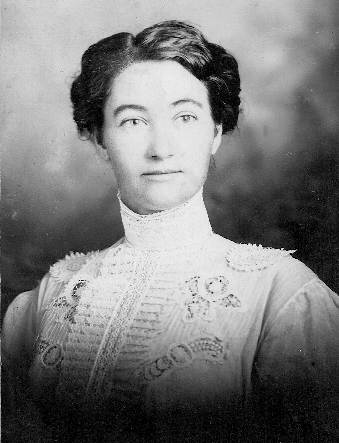 01 Louie Clarke Lawson
 02 Charles Clarke
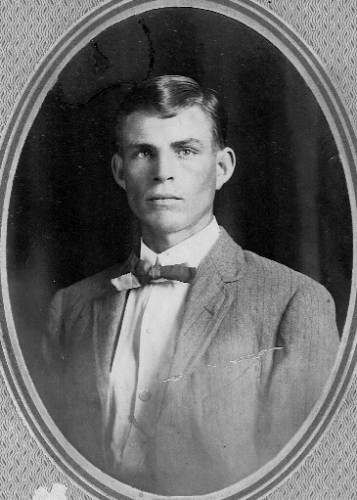 03 Claude Lawson The article below is copied as it was printed in the Autogram. The Editor's Note
was written by Clare Mace, who was on the staff of the Autogram at that time.
September 29, 1960
Miller County Autogram Sentinel
(Editor's Note: This history of Tuscumbia was
written by one of the community's "old timers," Louie Clarke Lawson, who writes
the Real Rural Rustlers news column for the Autogram-Sentinel. She and her husband live up
the river road from Tuscumbia (photo 04 of
couple). Mrs.Lawson, who was born in
Tuscumbia 80 years ago this fall, spent last winter preparing this historical article.
Clare Mace; Autogram correspondent)
 04 Claude and Louie Lawson Tuscumbia History
By Louie Lawson
The building of the new bank and post office on the
hill encourages me to try to write the story of Tuscumbia from its beginning.
It was in the early 1800's that two bachelor
brothers, James Pryor Harrison and J.B. Harrison built a log trading post on the left bank
of the slough to "Shut In Branch" near the big spring. James Pryor Harrison
entered the land in 1836. The first post office was established in that year in the
Harrison Brother's store. James Pryor Harrison donated the land for the town. It was also
early in the 1800's that a white man talking to an Indian was told that if he ever built,
he should have his sills above a certain mark on the bluff and the water would never reach
him. This man was Daniel Cummings or, "Uncle Dan" as he was commonly known.
He did as advised when he built the old house that
used to sit in the bluff side at the corner where the post office was until its recent
move.
Old Jesse Kendrick opened the first grocery and
saloon in 1838. He had built the first house near the town on the left side of "Shut
In Branch" close to where the ball diamond is and was buried there by an old slave. I
can remember the old log house there when I was a child.
Tuscumbia can boast of being the oldest laid out
town in Miller County, the most central county in Missouri. It has always been the county
seat.
The first court was held in William Miller's old
log house, on what is known as the Tellman place at the mouth of the Saline Creek about
six or seven miles below the town. The second term was held in the Harrison Brother's
store. It was then voted to name the town Tuscumbia. This name was thought to have been
selected for an old southern town in Alabama which also had a big spring.
The story goes that in naming the town, two names
were voted on, the names of the first white child born there, and a kindly old Cherokee
Indian Chief by the name of "Tuscumbia." The Chief's name received the most
votes. The name means "big spring" or "cold water." In 1838 bids were
open to build a court house. Lots were sold for a courthouse square, with a road running
around it in the same location as our present courthouse square. The building was to be
built of logs, one room, 35 x 20 feet with four good batten doors and four windows, and a
fireplace in the rear (photo 05). The lowest bid was $975.
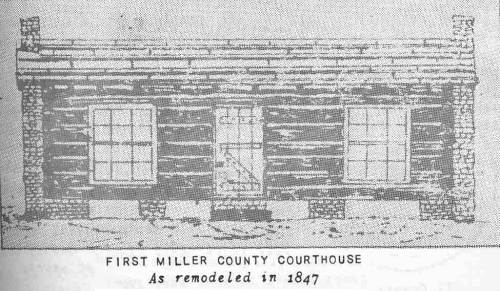 05 First Miller County Courthouse About the same time a jail, 19 x 19 feet, was
built. During all this time the town continued to grow under the hill between the bluff
and the river, with its fortress-like courthouse overlooking from its heights; the swift
Osage River and the bluffs on each side, confident of its reign for many years to come.
In 1857 bids were open for a second courthouse. The
lowest bid on this was $1000. It was to be a two story brick, 56 x 40 feet, with the
courtroom on the first floor in the rear, and offices in the front and on the second floor
(photo 06). In 1871 part of the second floor was leased to the Masonic
Lodge. In 1865 a new stone jail was built on the courthouse square. In 1879 one cell of
the jail was leased to the town for a calaboose.
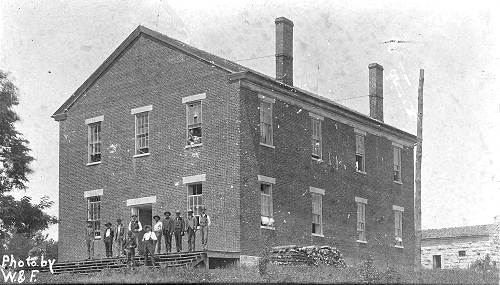 06 2nd Old Courthouse The first church in the town was an Episcopal
Methodist Church which was disrupted by its own members during the abolition movement. The
town, as well as the county and state, was divided by this movement. Sometime later the
church was turned into a grocery store and saloon, and 10 years later burned at the same
time as the Goodrich block and Lessum's Store.
After the burning of the church, people of the town
became alarmed and called a meeting whereby they appointed a committee to appear before
the court with concern to pray that they refuse the use of the courthouse to all abolition
preachers and speakers. The court granted their wishes, and until the war it was not open
or such purposes.
The first rebel flag was hoisted over the Harrison
Brother's Store
The town grew and prospered until the Civil War
when everything came to a standstill. After the war, houses began to be erected on the
hill. The first ones were the T.B. Robinson and W.W. Martin homes. I believe the Martin
home was built on the lots where the new post office and bank were built next to the
Christian church.
It was after 1870 that houses began to be erected
across the slough, the first one by W.H. Hauenstein, Sr. (photo 07 of house).
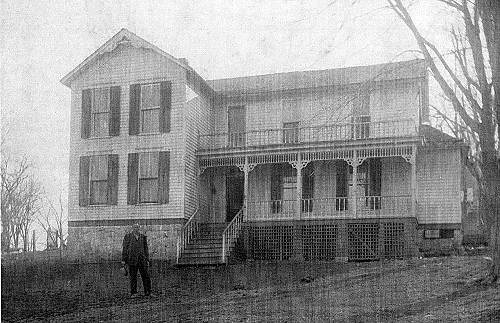 07 W. H. Hauenstein Home Then they began to be built around each side
of the bluff to the east and west. The town was now divided into four sections: the east
end, the west end, across the slough, and on the hill. Each of them acquired a remarkable
isolation for a town of its size and each also acquired a name of its own. The east end
was called "Crackerneck;" across the slough was called "Goose Bottom;"
the west end was named "Possum Flat;" and the fourth part of town above the hill
was called "Above the Hill."
(Note: the next photo (photo 08)
includes another description of the commonly used names of Tuscumbia written by David
Bear.)
 08 Tuscumbia before 1900 Click image for a larger viewThe town itself continued to cling to its
original location between the bluff and river in its zig zag way almost forming a Z
pattern.
W.H. Hauenstein, Sr. or "Grandpa
Hauenstein," as he was later known by everyone, came to this part of the country in
1865 from Rhine, Bavaria, now Germany (photo
09).
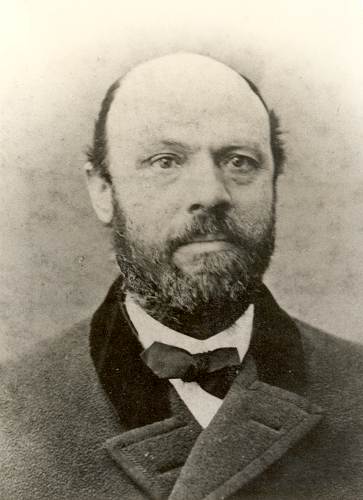 09 William Hauenstein Sr. 1822-1913 He purchased a grist and saw mill which stood
above the mouth of Gum Creek, a mile and a half from town. He used oxen for hauling and
transporting him back and froth from town. He once became aggravated at them for lying
down in a pool of water to cool off and moved the mill farther down the river to
"Goose Bottom." After the move, his two sons, W.H. Hauenstein Jr. and Phillip Hauenstein
(photo 10) took over the operation of the mill;
Bill the grist part and Phil the saw mill. (Photo
11: this photo includes a brief history of the mill.)
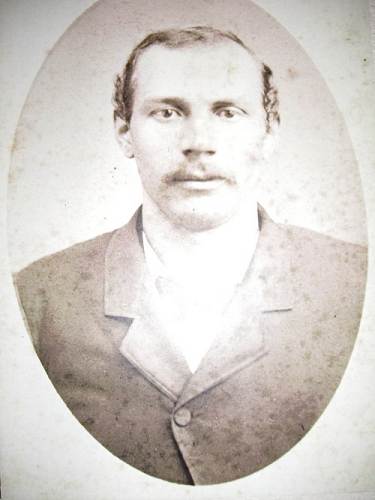 10 Phil Hauenstein
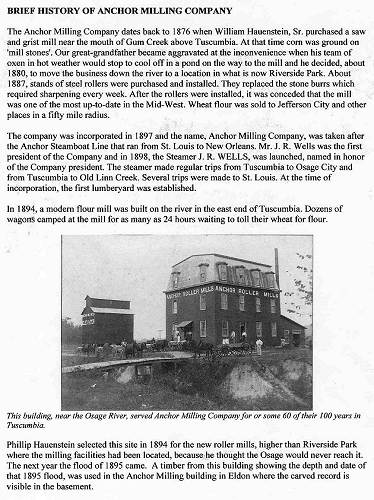 11 Brief History of Anchor Mill Click image for larger viewWilliam Sr. then returned to Germany to
settle his business and when he returned, he brought his nephew, George T. Hauenstein
(photo 12), then twelve years old, back with him, where he lived until
he was married. After his return here, he opened the first Hauenstein Store (photo 13), in the same location and building as the present one, and
his nephew worked for him.
 12 George and Ida Hauenstein
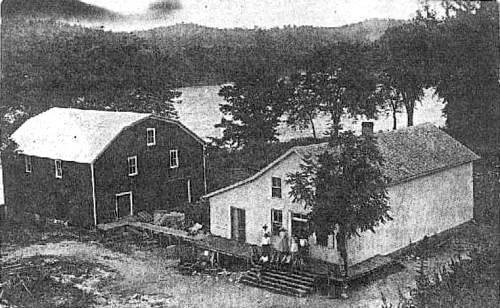 13 Hauenstein Store with Shed Here I'd like to say I was born November 17,
1880 in a log cabin on the bluff back of the Presbyterian Church, the eldest daughter of
Charles H. and Isabelle (Skinner) Clarke. My father was a native of London, England, and
after coming to this country made his home with Grandpa Hauenstein and worked for him.
My first remembrance of the town was at the age of
five. I lived in a large old three story house that sat against the bluff across from the
Hauenstein Store. My mother kept a restaurant on the first floor and lived on the second,
which opened onto the bluff. When my mother was busy, my sister and I would slip out of
the back and across the bluff to the old hotel (photo 14). What impressed
this on my mind, I think, was that my mother passed away there in 1885.
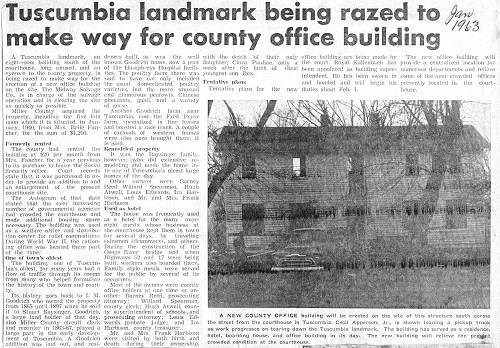 14 Old Hotel Click image for larger viewIn 1857, Captain Robert M. Marshall (photo 15), who was a pilot on the steamboats of the Osage and
Missouri Rivers, heard of a new process for making wheat flour, and talked the Hauenstein
Brothers into installing the new "roller" type mill (photo 16).
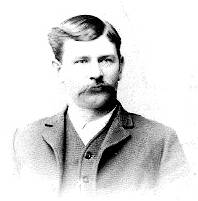 15 Robert "Bob" Marshall
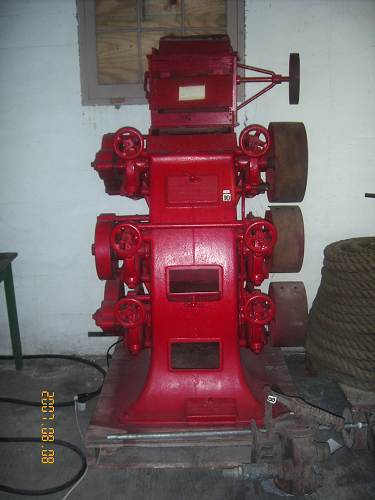 16 Roller Mill Machinery Captain Bob was to furnish one half of the
capital. He then became associated with them and for many years served as president of the
mill. The rollers were purchased in Indianapolis and transported to the mill by steamboat.
It then became the most up to date mill in the Midwest (photo 17). It was nothing
to see dozens of wagons and teams camped around the mill for as long as twenty four hours
awaiting their turn to have their grain ground (photo 18).
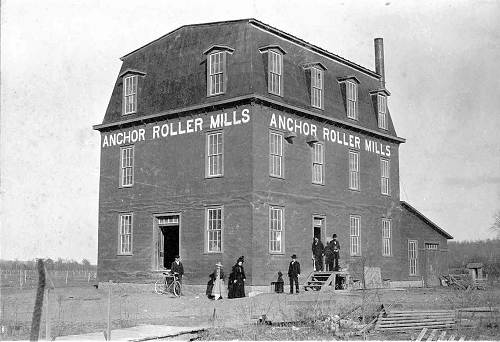 17 Roller Mill
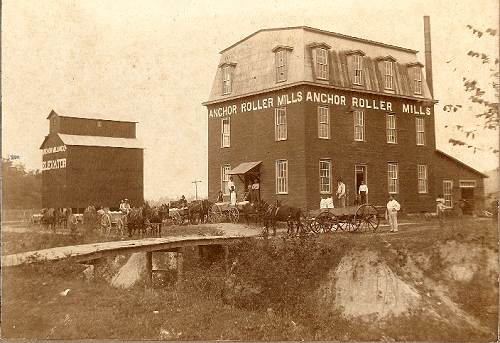 18 Old Mill - 1897 - Steam Powered Flour was sold to Jefferson City and points
fifty miles away. Captain Marshall sold his share in the mill to the Hauensteins after a
few years and it has been in their family and corporation ever since.
The Osage River was a blessing as it was our best
source of transporting supplies in and commodities out. It could also be a very
destructive thing, especially when it went on a rampage with flood waters, which usually
happened about twice a year (photo 19).
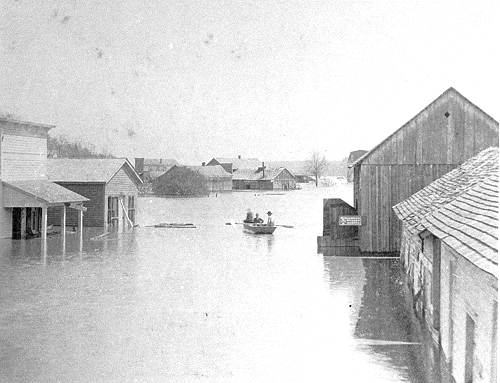 19 Downtown Tuscumbia Flood Scene It was first traveled by Indians and white
trappers in canoes. There is every indication that Indians had lived in and around
Tuscumbia as several of our townships were named for them. The first steamboats on the
river were the McClurg lines. Governor McClurg's boat, the "Emma," was in
service as early as the 1860's, from Osage City to Linn Creek. Governor McClurg built a
large home on a high hill at Linn Creek. Many boats were in operation in the 1870's and
1880's. One boat mentioned was the H.C. Coleman, laden with merchandise for Tuscumbia
merchants. It would arrive here 24 hours after leaving Jefferson City.
A little later came the "Thomas H.
Benton," "The Helena," and "The Golden Gate," all of which were
big boats. The largest and most palatial boat to land at Tuscumbia was the "Golden
Gate." It was 250 feet long and had four decks. Above the lower deck was a cabin for
the laborers, and above that a cabin for the officers. The pilot house was located on the
top deck. It was a beautiful sight to see it lit up a night, with the whistles blowing,
bells ringing, and the Negroes singing. The steamboat "Tuscumbia," owned by a
corporation of Jefferson City men, was used almost entirely for carrying the mail. It
would leave Jefferson City at 6 a.m. and arrive here at 6 p.m. My first boats to remember
were the "Frederick" (photo 20)
and "John R. Hugo" (photo 21) which were more closely associated with the town as they
were owned and operated by Tuscumbia men.
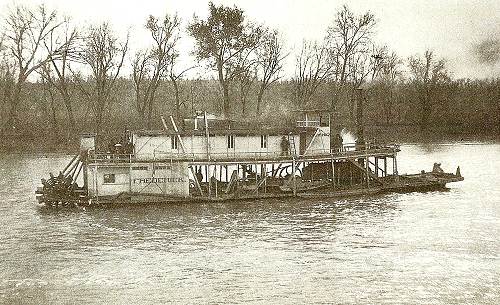 20 Frederick on the Osage
 21 John R. Hugo owned by Bob Marshall Captain W.H. Hauenstein Jr. built the
"Frederick" in 1882 to bring freight and merchandise up the river for the
Hauenstein Store, owned by him and his father. Captain Marshall, who had been a pilot on
the "Hugo" for several years, purchased it in 1883, making connections with the
Missouri Paciic railroad at Osage City. They made an agreement that they were to deliver
freight to this boat and he all commodities and freight from the river to them. Captain
Marshall said this agreement was never broken.
In the 1880's Tuscumbia had become a busy,
prosperous little town. Both the bluff side and river side were lined with business
places. The busiest of these were the Anchor Milling Company, owned by Phillip F.
Hauenstein and Captain Robert Marshall; and the steamer "Frederick" owned by
W.H. Hauenstein, Jr. The merchants of the town were Hauenstein and Company, Simpson and
Company, F.W. Fendorf, I.T. Johnson and B.F. Lawson Groceries, and I.T. Johnson also ran
the ferry (photo 22).
 22 Ferry Landing at Tuscumbia The town had three hotels: "The
Home" (photo 23), Ludwell Bacon, proprietor; "The City Hotel,"
Mrs. E.R. (Ed) Freeman, owner; and the Kentucky Home," Mrs. J. Bell, manager. All of
the old Hotels are gone but "The Home," last owned and operated by Judge and
Mrs. J.N. Brockman, and now an apartment house owned by the Brockman heirs.
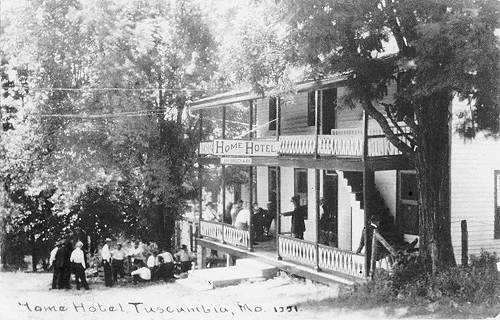 23 Home Hotel J.W. Fogelman (photo 24) was the
liveryman and George Bacon, the hack line and mail. This Mr. Bacon operated for 20 years
or more. Page Thompson had the shoe repair shop and I.N. Reed was barber.
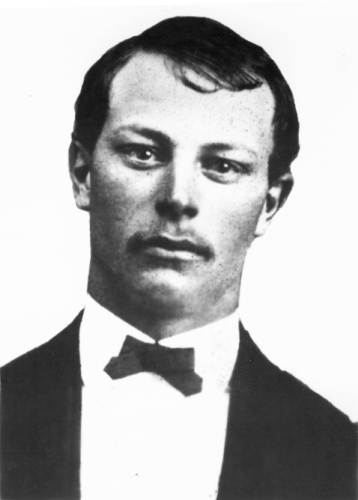 24 John Wilson Fogleman b. 1851 John Kallenbach and John Weitz were the
blacksmiths and ran the wagon shops. The Kallenbach shop was at the east end of town and
Mr. Weitz's shop was back of the bank. Mr. Kallenbach also built a large home just west of
the old Woodman Hall, and Mr. Weitz had a large old log house just below the "Home
Hotel." This my father bought when he remarried in 1890, with a plot of land
following the "Shut In Branch into "Possum Flat." This was laid out in lots
and is now known as Clarke's addition to Tuscumbia (see the plot map of Tuscumbia where Clarke's addition is on the west side on our website history of Tuscumbia:
http://www.millercountymuseum.org/communities/tuscumbia.html).
Herman McCarty was our saddler. Milliners were Mrs.
J.P. (Carrie) Wright and E.C. Swalem. The quarries were owned and operated by Dr. J.B.
McGee (photo 25) and W.J. Welshous. The carpenter was J. W. Willis, and the
mason was Jim Jukes.
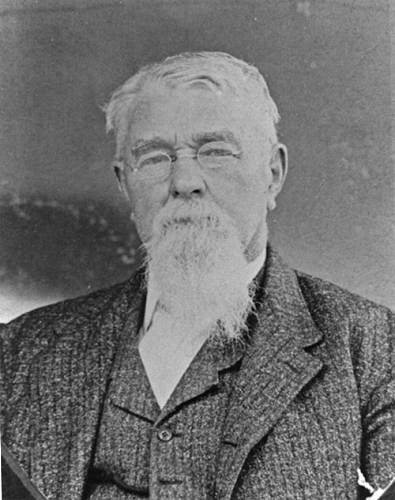 25 Dr. James McGee The resident lawyers were T.B. Robinson, E.C.
Swalem, L.N. Musser, and E.C. McIntire. Doctors were J.B. McGee and S.W. Ewell. George T.
Hauenstein (see photo 12 above) was married in May of 1886 after which he went into the
general merchandise business in the old Hauenstein store that fall. They started on a
small scale, but it grew rapidly becoming one of the largest of its kind in this part of
the country.
George T. passed away in 1911, but his wife,
Ida (McCommons) continued to operate the store with the help of her nieces,
Julia, Sadie, Ina and Ruth McCommons. She passed away in 1948, leaving her estate to her
nieces. Many descendants of these folks still live here and make up the greater part of
our town now.
Both the Christian and Presbyterian churches
were dedicated in 1889.
(You can read the history of these two historical churches on our website at:
http://www.millercountymuseum.org/churches.html)
These were the first churches the town had since the
burning of the Methodist Church during the abolition movement. Up to this time, services
were held in the courthouse. The construction material for both was brought up the river
by Captain Marshall's boat free of charge.
The newspapers of the town have a rather unusual
history. The first one was the Osage Sentinel from 1871-1875, when it was moved to
Richland. Also, in 1871, a Mr. Gustin started the Republican, which soon joined another
paper of his elsewhere, and was bought by I.M. Goodrich, who sold one part to J.P. Wright
and J.H.D. Thomson, and the other part to a Linn Creek party. Mr. Wright and Mr. Thomson
converted their paper into a religious paper called "The Gospel Proclamation."
In 1872, The Miller County Vindette was started as
a Republican paper, its editor was P. Goodrich, who sold it to I.N. Goodrich and A.
Fulkerson, who resold it to a Linn Creek firm. About this time, "The Gospel
Proclamation" was changed to a Republican paper with J.P. Wright as editor. This was
discontinued due to the health of Mr. Wright.
In 1876, "The Helmet," by L.S. Hitchcock
fell into the hands of I.M. and F.M. Goodrich as the "Miller County Republican."
In 1885 Mord McBride moved his paper, "The Miller County Autogram," to Tuscumbia
from Aurora Srings. This he edited for 25 years. He sold it in 1910 to E. Martin and
William Bear (photo 26) who resold it to W.S. Stillwell (photo 27) and L. A.
Wright, son of J.P. Wright, who edited it for 20 years. Since then it has changed hands
several more times and is now owned and edited by the Eldon Printing Company as the Miller
County Autgram Sentinel.
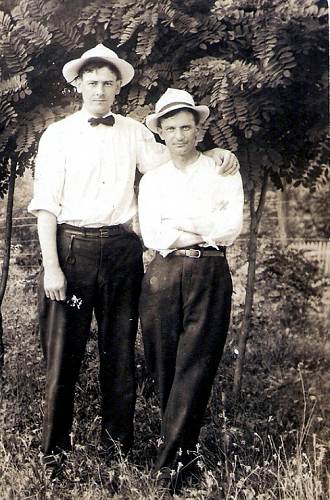 26 Will Bear and Ed Clark
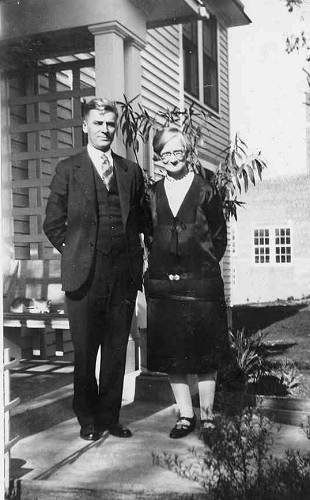 27 Walter and Lydia Fendorf Stillwell In 1897 the Anchor Milling Company, in
expanding its business, moved to a third location in "Cracker Neck," where the
company had erected a large three story and basement building. Soon after they moved they
built an elevator with modern machinery. Later they added a lumberyard and hardware store.
In 1898 they built the steamboat "J.R.
Wells," (photo 28) named for one of its principal stockholders. They also
built a barge, "The Ida," which was kept busy during the boating season hauling
out wheat, livestock, and other commodities.
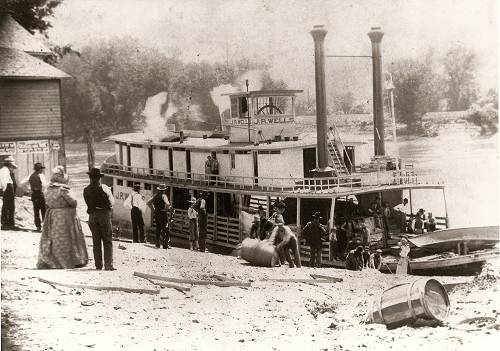 28 J.R. Wells unloading at Tuscumbia In 1908 J.R. Wells built the "Ruth"
(photo 29) for a pleasure craft, but it was never used as such as there
was so much red tape in getting a pilot and engineer license. They say that in naming the
"Ruth," Mr. Wells placed the names of his six children into a hat and drew one,
Miss Ruth, his third daughter, now Mrs. Guy Sone of Jefferson City, received the honor.
This boat was sold to the Anchor Milling Company and the deck was removed and used to haul
grain to the mill. They also built the "Dauntless." The last boat built by the
mill was in 1919 and was named for the present president, Homer C. Wright (photo 30).
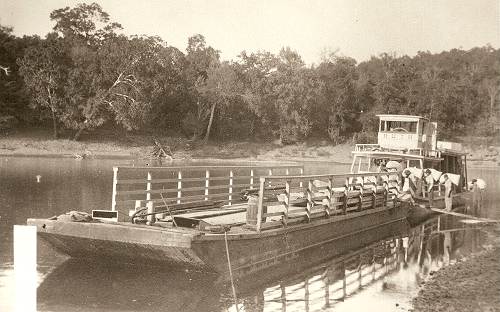 29 The Ruth with barge
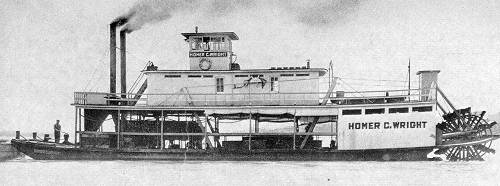 30 Homer C. Wright Steamboat Soon after the construction of the Homer C.
Wright transportation opened up overland to the Missouri Pacific Railroad at West Aurora.
With the pattern of cutting rates, it became unprofitable to continue the river freight
business and the Homer Clay Wright was sold.
In 1936, the mill was changed from steam power to
diesel power. After the big flood of 1943, when their lumber shed collapsed, the Anchor
Mill became weary of rebuilding and cleaning up after floods. That year they built their
hardware store and lumberyard on the hill at its present location. In 1948-49 they built
the present mill on the hill and moved for the fourth time in 1949.
The current president is Homer Clay Wright (photo 31), grandson of Phillip Hauenstein. Ralph V. Wells is
vice-president, and Bamber Wright (photo
32), grandson of Captain William H.
Hauenstein Jr., is secretary treasurer. The mill has expanded until it has now three sales
rooms: Eldon, Eugene, and Tuscumbia, and is still the largest one of its kind in Miller
County. It has 16 to 18 employees at all times.
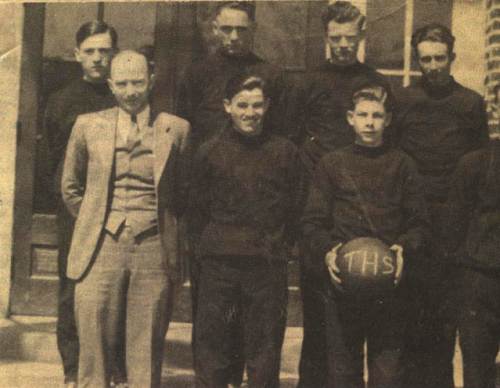 31 THS Boys Team 1935 - Coach Homer C. Wright on left
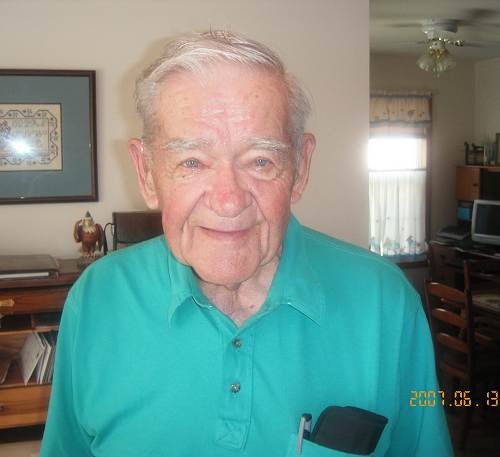 32 Bamber Wright - June 13, 2007 The first wharf was built in 1890 and the
first ferry was operated by oars and tolls. The first licensed ferry was operated in 1837
and folks would be surprised at the prices that were paid. The ferryman could set his own
price. Our first bridge across the river was a swinging bridge and it charged a toll
(photo 33 swinging bridge). It was dedicated in the summer of 1905 and a big
dedication picnic was held just south of the river where the toll house was located.
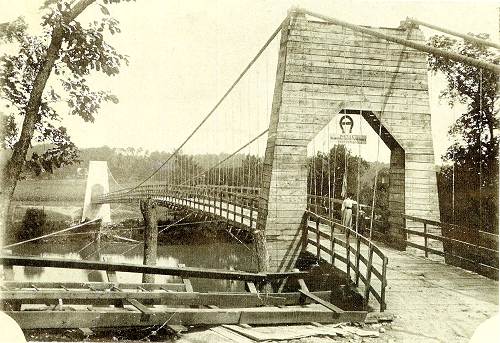 33 Suspension Bridge at Tuscumbia 1905-1934 Our stationary bridge was built in 1933
(photo 34). This was built by state and federal funds and no toll was
paid. It was a booster for our town as folks from the south side could do their shopping
here without paying a toll.
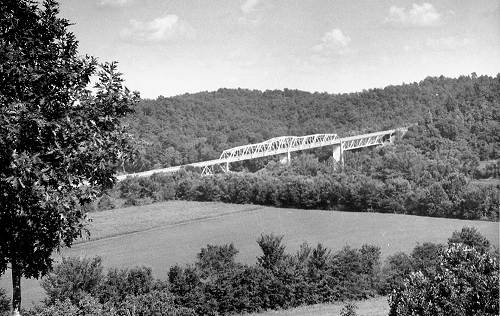 34 New Bridge at Tuscumbia In the early 1900's while excavating for a
basement to the courthouse, due to a heavy rain, part of the courthouse gave away and fell
into the basement, records and all. Bonds for a new courthouse were voted on, but failed
to pass. The county court could repair the building, but not build a new one. The work was
started in 1910 and finished in 1913. An arch was added to each end and a rock wall built
all the way around with the old courthouse in the center. The old building was 56 x 40
feet and when finished, it was about 120 x 65 feet (photo 35).
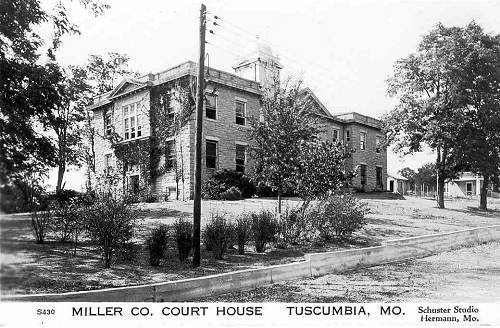 35 Miller County Courthouse (Note: I can add some more information about the "addition" to the
old courthouse since my great grandfather, David Christian Bear (photo 36) was presiding judge of the county court at the
time.
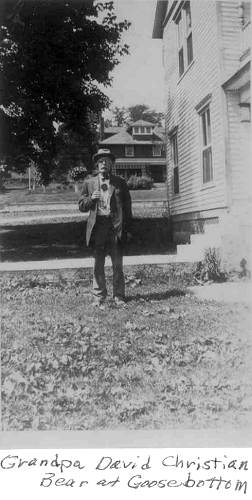 36 David Christian Bear Although the need for increased space and improvements for the courthouse was
recognized by many people, a dispute arose as to where to build a new courthouse. The
Eldon residents wanted to move the county seat north but that didn't please those people
who lived in the south part of the county, especially Iberia, which didn't want to have to
travel all the way to Eldon to go to the courthouse. Because of this disagreement enough
citizens were against building a completely new courthouse that a bond could not be passed
to finance it. So the County Court decided to make some of the "improvements"
mentioned by Louie Lawson above which, in actuality, was somewhat of a ruse because when
all was said and done, the "improvements" were sufficient to have equaled the
size of an entirely new structure. I was often told this story by my grandfather, Madison
Bear, who always remembered it with some amusement.)
The first bank (photo 37 of bank) was
organized about 1903-1904 through the efforts of Robert Marshall (photo 38) who personally worked to recruit and solicit stockholders.
He became the first president and this post he held until his death in 1954 at the age of
95.
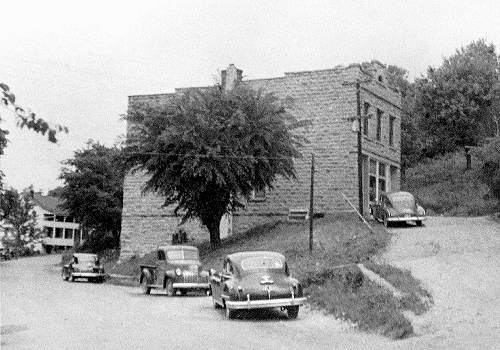 37 Bank of Tuscumbia
 38 Robert Marshall and Fred Fendorf My brother-in-law, X.X. McGee, son of Dr.
J.B. McGee and grandson of Dan Cummings, tells me that the large old house that used to
set on the edge of the slough (photo 39
McGee house on left in Goosebottom) back of Hauenstein's Store
was built by Mr. Cummings at Aurora Springs and moved by his father, Dr. McGee, who also
moved here from Aurora Springs.
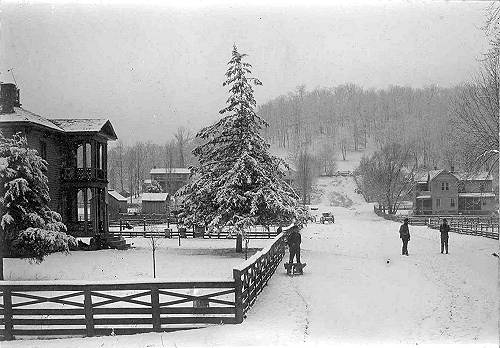 39 McGee house on left; Phil Hauenstein house on right The house was a two story, sturdy building.
The sills and underpinning were sawed by hand with a cross cut saw from large logs. It had
a considerable amount of walnut lumber in it. After the move two stories were added. One
was used for an ice house. Mr. Cummings and family lived on the second floor, and he had a
large general merchandise store on the first floor. Dr. McGee's office was also on that
floor.
The I.T. Johnson house and the old Fendorf house
(photo 40), now owned by Mr. and Mrs. Hannis and Ella (Fendorf)
Swanson, are also among some of the older homes.
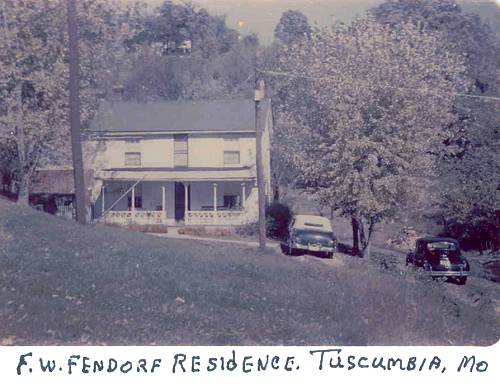 40 Fendorf residence in Tuscumbia Mrs. Swanson is the daughter of F.W. Fendorf,
who was in the mercantile business in the 1800's. Another old home was the R. M. Marshall
house (photo 41) built by W.H. Hauenstein Sr. in the 1870's. Another old home
was that of William Hauenstein Jr. next to the R.M. Marshall home (photo 42).
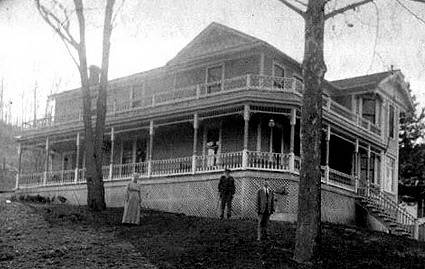 41 Robert Marshall Home
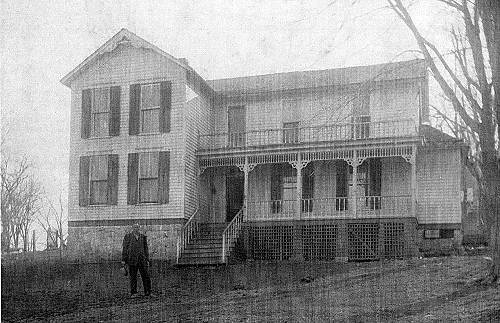 42 W.H. Hauenstein home The oldest house on the hill is the old I.M.
Goodrich house (photo 43). It is now owned by Dr. M.E. Humphreys. It was at one time
the show place of the town-a large old two story house with separate quarters for the
servants and a lovely old wooded park surrounding it.
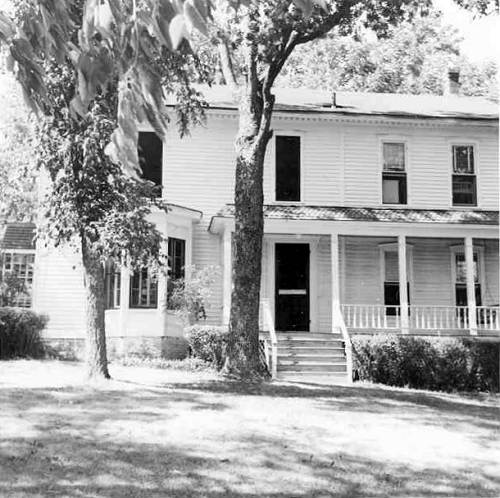 43 Goodrich house It was a lovely place for a picnic or big
political rallies. I remember one year we had a large Republican rally that formed at
Eldon and other towns north with elaborate floats, gathering momentum as it reached
Tuscumbia. It is said the parade was two miles long. Then the parade from the south joined
them. It was a very exciting time. Dr. M.E. Humphreys converted the old house into our
first hospital in 1948 and built his house in the park next to it (photo 44).
 44 Humphrey house on hill - 1939 In 1953, Dr. M.E. Humphreys and brother, Dr.
Stanley Humphreys, built a large addition to the hospital. We now have a modern, fully
equipped hospital with laboratory and X Ray rooms, 18 bed capacity which can care for more
in an emergency, a registered technician, druggist, bookkeeper, dietitian and auditor. It
has its own laundry facilities, eight nurses, medical record supervisor, and receptionist.
We are justly proud of our hospital, as it is the only one in Miller County.
The first school I can find any trace of was a log
school house that stood in "Possum Flat" just west of our old house. The seats
and desks were made out of split logs. The first one I can actually remember myself was
when dad married again. We came back to town when I was 10 years old. It was a large
brick, one story building with a partition in the center that didn't reach all the way to
the top. We used to throw notes back and forth.
In 1895-96 a two story frame house was built on the
front of the lot where the present high school is. There were two rooms below and one
large room above. I finished school there in 1899 (photo 45).
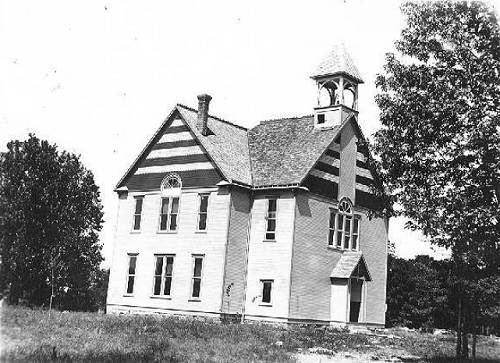 45 Old Tuscumbia School - 1920 The river, as I have said, could be very
destructive when it went on a rampage with flood water. The folks in "Goose
Bottom" were the hardest hit. I have seen it come so fast they would have to move out
in the night.
The Robert Marshall, W. H. Hauenstein Jr., and
George T. Hauensteins (photo 46 George
T. Hauenstein home) had built on the side
of the hill. George T. Hauenstein would have to move to the upper floor but I don't
remember the Marshalls and W.H. Hauensteins ever having to evacuate. I have seen it flood
their basements and get to the top steps of their porches.
 46 George and Ida Hauenstein home The Phil Hauenstein (photo 47), Dr. J.B. McGee, Dr. D.H. Kouns and George Swanson homes
were in the bottom. Many times you could only see the combs of the roofs the large two
story houses of Dr. McGee and Dr. Kouns.
 47 Phil Hauenstein house - 1883 The water came so fast one time that the Phil
Hauensteins couldn't get their large piano out so they tied it to the ceiling. It was too
large to get up the stairs. All that's left of the houses in "Goose Bottom" are
the Robert Marshall, William H. and George T. Hauenstein homes. The floods buffeted and
weakened the others until finally they were removed.
(Note: my great grandfather, David C. Bear, bought the Phil Hauenstein home about
1925. He lived there with my grandfather Madison Bear and his family until his death in
1941. My grandfather told me that the biggest flood ever recorded was in 1943, and he, as
did Phil Hauenstein, also had to raise his piano up off the floor with pulleys.
Unfortunately, the '43 flood was so high that for the first time since the house was built
the flood reached the upper floors which were ruined. Grandfather Madison did not want to
try to restore the home so he sold it to a man from Eldon who disassembled it and built a
smaller home in Eldon).
One year at Christmas many folk had bought presents
and had them laid back at Hauenstein's Store. The river flooded that year and came up so
fast that we had to have our community Christmas tree at the courthouse on New Year's as
we could not get to the store to get our presents in time for Christmas.
In 1901 the river was frozen over solid and wagons
and teams crossed on the ice for nearly two weeks. At such times we would fill our ice
houses for our summer supply of ice by cutting large cakes of ice and putting them up in
sawdust in our ice houses.
One year we were practicing for a Christmas program
and we had a big snow. It was several inches deep with sleet and ice on top. We walked and
slid up and down the hill for nearly two weeks.
In the winter there was great sport for old and
young. The river would be covered with skaters who could skate five or six miles each way.
Then there was sleigh riding and coasting. One hill that was great was the Uncle Billie
Clark hill above the Saddle Club arena. We would start at the top with our bob sleds
loaded with five or six, and if we weren't dumped we could coast half way across the
pasture.
On the other hill we would start at the courthouse
and coast down the hill past the old Fendorf home and half way across
"Crackerneck" (photo 48, sliding
in Crackerneck). One time Frank Fendorf Jr.
started down head first and ran into Mary Nichols' woodpile and almost disrobed himself.
Another time Ernest Fendorf went down head first and ran under Jim Pink Wright's old cow.
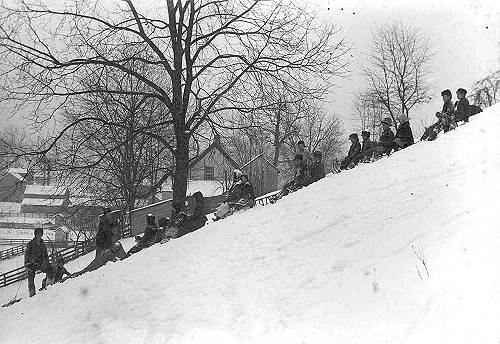 48 Sliding hill in Crackerneck Those were glorious times. We had to make our
own amusements. The younger generation doesn't know what it means to be born 30 years too
soon.
After the flood of 1943 the business places
commenced to move onto the hill. As I have said, the mill was first. Then in 1946-47
Denzel Slone built a locker plant. Dewey E. Kallenbach built an electric shop on Highway
52, and Leonard Kallenbach and Walter S. Stillwell built a duplex building north of the
courthouse. Leonard Kallenbach put in a grocery store and café and Walter Stillwell and
abstract office.
Glen Warren built a large garage which has been
converted into a grocery store with Roy and John McNeely, proprietors. Ellis Smith now
operates the Hillcrest Café.
We have two poultry processing plants; the
Riverview with 23 employees and the Ozark with 16-18 employees. We also have two novelty
shops: the Pryor Novelty Company owned by Ansel, Fred, and Harold Pryor employing 23
people; and the C.O. Brockman Novelty with 21 employees. We can rightly say that of a town
of its size we furnish more employment than any town I know of.
Thanks Louie.
Of course, since 1960 when Louie wrote the preceding history of Tuscumbia many changes
have occurred. As has occurred to many small towns, Tuscumbia has ceased to grow as many
of the younger people have left the area seeking employment opportunities that the local
area no longer can provide. Many of the businesses once located in Tuscumbia no longer
exist and most of the shopping by local citizens occurs in larger towns nearby, especially
Eldon and the Lake area. For those who were born and raised in Tuscumbia a sense of
profound nostalgia is felt whenever we drive down the "Baptist Hill" and look
over at "Goosebottom" where so many of the old houses no longer are standing;
when we see the crumbling stone walls of the old bank; the fallen walls and roof of the
Presbyterian Church; when going on down to the river where we no longer can find the old
Hauenstein's Store nor the old Woodman Hall building where my grandfather, Madison Bear,
had a grocery store and where later other proprietors had businesses. The old Anchor Mill
buildings along side the river are mostly gone as is Thompson's garage as one makes their
way up through the "Crackerneck" area. So it is good that Louie Lawson wrote
down her memories of the time when the streets of Tuscumbia were filled with horses and
wagons, and later cars and trucks; when the store buildings and homes and were still
standing, when people crowded into them daily to carry on their business activities and to
meet and socialize with their friends. Only those who are old enough to have been there
then can really understand the sense of loss experienced when one of us sees the remnants
of what is left of what once was a vibrant and busy community.
Progress continues on the renovation of the original museum building. The first stage of renewing the electrical wiring and placing new electrical and lighting outlets has been completed. Next week the dry wall and painting will be started for the inside of the old building. After that we will begin constructing the new display areas. Opening day this spring may be delayed but when that day arrives it will certainly be a "Grand Opening!"
That’s all for this week.
| 


